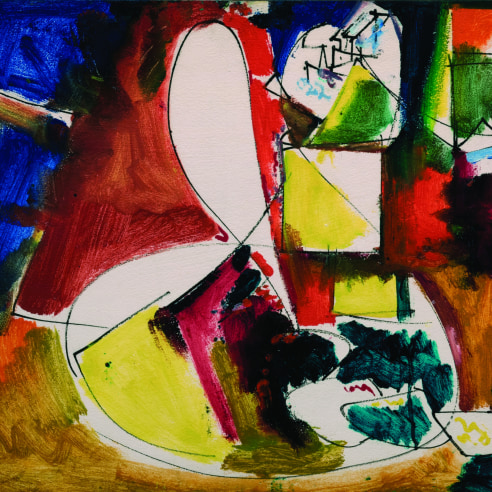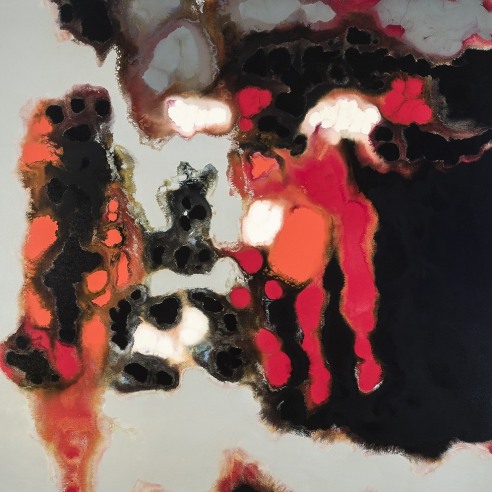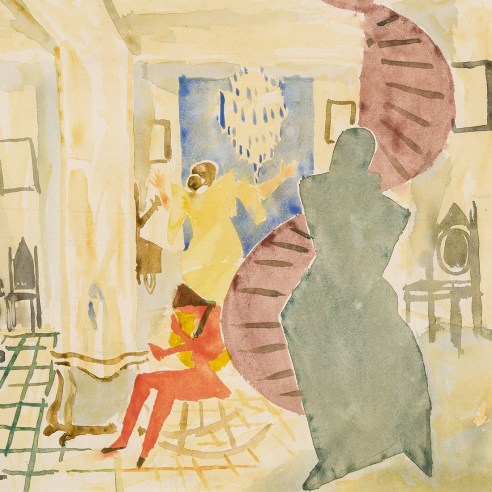
Stuart Davis was a child of the Ashcan School. His parents, Helen Stuart Foulke and Edward Wyatt Davis, met as students at the Pennsylvania Academy of the Fine Arts. Helen Foulke Davis was a sculptor; Edward Wyatt Davis was the art editor of the Philadelphia Press when Stuart was born. The elder Davis supervised, at various times, John Sloan, George Luks, William Glackens, and Everett Shinn. In 1901, Edward Davis joined the Newark Evening News, and the family moved to East Orange, New Jersey. In these surroundings, there was no surprise or family opposition when Stuart Davis decided to leave high school after one year to seek serious art training. His parents entrusted the fifteen-year-old to their old Philadelphia friend, Robert Henri, who ran the Robert Henri School of Art in New York City.
Davis’s first work was in the realist/impressionist Ashcan style; his first mentors were artists of the Ashcan school, and among these he was particularly close to John Sloan. Davis studied with Henri from 1909 to 1912. In that year he set up a studio in Hoboken with Henry Glintenkamp and went to work for The Masses, a socialist journal where John Sloan had assembled a young group of artists that, in addition to Davis, included Glintenkamp, George Bellows, and Glenn Coleman. Davis showed five watercolors at the 1913 Armory Show. The significance of the show for him, however, was not his own participation, but the opportunity it afforded to see the latest currents in European art. He wrote, in a 1945 autobiographical manuscript:
I was enormously excited by the show, and responded particularly to Gauguin, Van Gogh, and Matisse, because broad stylization of form and the non-imitative use of color were already practices within my experience. I also sensed an objective order in these works which I felt was lacking in my own. . . . I resolved that I would definitely have to become a ‘modern artist’ (as quoted in Diane Kelder, ed., Stuart Davis [1971], p. 23).
Though the revelation did not immediately transform his art, the experience of the Armory Show set Davis on a path of self-directed exploration that he systematically and consciously pursued for the rest of his life.
Davis first went to Gloucester, on Cape Ann, Massachusetts, in the summer of 1915, drawn by the enthusiastic reports of John Sloan. The small fishing village proved a seminal spur to his artistic imagination, from his early realist images, to the tentative experiments with modernist forms of 1917–18, to the frequent use and reuse of motifs with Gloucester associations throughout his career. The reappearance of the same motifs in different configurations strikes a note of constancy in an oeuvre characterized by periodic style shifts. Through the decade of the 1920s, Davis experimented with the formal language of cubism, combining European-derived artistic methodology with iconic American visual images. This period culminated in his famous “eggbeater” series. In 1928, through the patronage of Juliana Force (and the funds of Gertrude Vanderbilt Whitney), Davis went to Paris for a year. He returned to continue his exploration of paintings created by the use of snippets of recognizable images abstracted and juxtaposed in deliberate fashion to become other than the sum of their parts. (Davis, who was a passionate lover of music, and jazz in particular, can be seen, in this respect, as a forerunner of today’s hip-hop DJs, combining diverse grooves.) Davis was, throughout his career, a conscious creator of art. In diary form, he recorded a running commentary on what he was doing—on the relationship between theory and practice. On December 30, 1922 he wrote, under the exclamatory heading “ART”:
The subject of a work of art may be of the most trivial nature or it may be of the highest moral and social significance, but in either case it is of secondary importance from the standpoint of the artist. I see all expression in terms of color. The work COLOR includes, AREA, PLANAL BALANCE, TEXTURE. A work is built by the superimposing of colored planes. . . . ART IS ART, that is to say, a work of art can only be such by intention (quoted in Kelder, pp. 36–37).
The 1930s were years of intense political activism for Davis. In common with many other artists, he faced financial disaster in the wake of the stock market crash of 1929 and the ensuing Great Depression. Beginning in 1933, and continuing until 1939, Davis was employed by the Public Works of Art Project (later the Works Progress Administration, WPA). During that period he served as President of the Artists Union in 1934, and the editor of its magazine, Art Front, in 1935–36. He was a charter member of the American Artists Congress and served as its Chairman in 1937–38. Davis was a polemicist; he was an organizer, a joiner, a speaker, and a writer, arguing his concerns on the printed page and the picket line.
Davis found himself in the 1930s in a position which seemed, on the surface, anomalous. (Lowery Stokes Sims discusses the issue at length in “Stuart Davis in the 1930s: A Search for Social Relevance in Abstract Art,” in Stuart Davis: American Painter, exhib. cat. [New York: The Metropolitan Museum of Art, 1991], pp. 56–81.) Soviet-inspired Marxists championed Socialist Realism in art, on the grounds that it was accessible to the working class (and thus useful as a propaganda tool). The closest American equivalent was Regionalism, advocated by the critic Wayne Craven and practiced by the artist Thomas Hart Benton, two men who were increasingly identified with right-wing politics. Davis was an unabashedly left-wing artist, as committed to modernism in art as he was to a progressive political agenda. He argued strenuously that it was possible to create an art that spoke a modernist language that could be understood by the working class. Davis was never a political artist in the narrow sense. He did not produce agitprop and emphatically denied that art served ideology, but he believed that the artist could convey his emotions and ideas through his chosen medium to any and all who looked. In 1935 he wrote that:
Art is not and never was a mirror reflection of nature. . . . Art is an understanding and interpretation of nature in various media. . . . We will never try to copy the uncopyable . . . This being so, we will never again ask the question of painting, ‘Is it a good likeness. . . ? Instead we will ask the question, ‘Does this painting which is a defined two dimensional surface convey to me a direct emotional or ideological stimulus? (quoted in Kelder, p. 113).
On this basis, there was no reason why Davis could not communicate his emotions or ideas to the working man or woman.
After a period of diminished productivity, ill health (and likely heavy drinking) in the 1940s, Stuart Davis rebounded with new energy and curiosity at mid-century. (See William C. Agee, “1950–1955” and Karen Wilkin “1956–1959” essays in op. cit. A Catalogue Raisonné: Volume One Essays and References, pp. 98–103 and 104–108 respectively.) In this post-war period, Davis found himself once again in a familiar, but still anomalous, position. He was a recognized “master of modern American art” whose work could not be described with the label of any school or style. Now we prize this quality in Davis’s work. Davis is distinctively Davis and there is no mistaking his work for anyone else’s. As a working artist, however, the problem was how to go forward. As Agee and Wilkin outline in their essays, Davis solved the problem by looking back to his own work, revisiting and revising the issues that had provided inspiration for years. In 1960, Jazz critic Rudi Blesh published a small book, Stuart Davis (New York: Grove Press, 1960). On the subject of what to paint, Blesh described Davis’s stance:
A constant Davis trait is the return to early subjects to develop them in a later manner. “You have to have a subject,” he remarks casually. “Why wander around? I take what I can get—even one of my own paintings.” But it is quite evident that the practice affords him satisfaction as well as a gauge for his progress. For, in a more serious vein he observed, “I can take a painting I made forty years ago and use it as a basis for developing an idea today. . . . I am not looking for something newer and greater. Everything new and great already exists—has always existed. We need to make our connection with it” (pp. 57–58).



